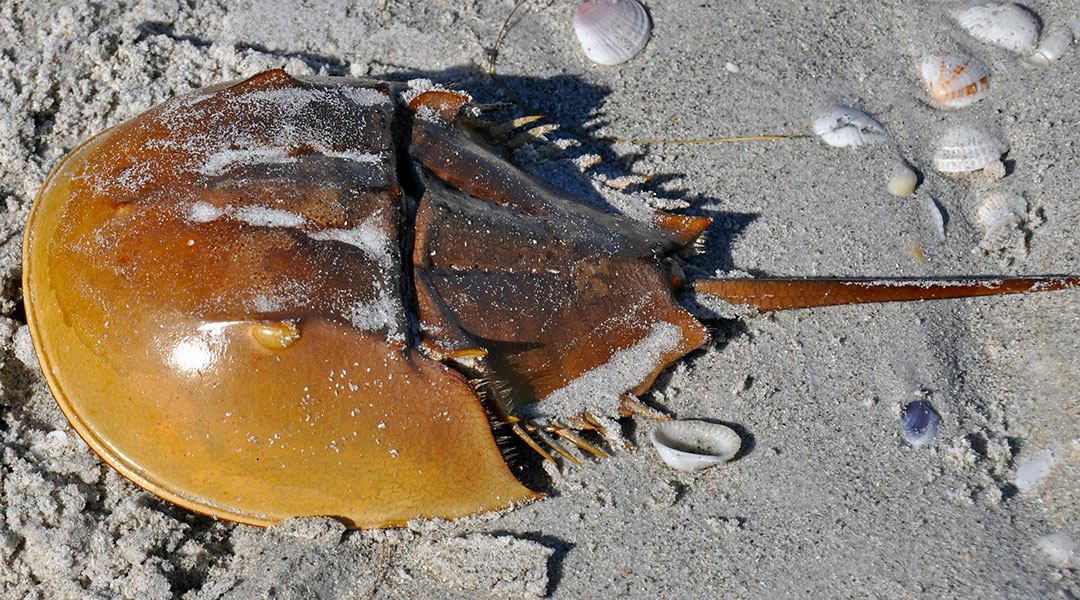“Evolutionarily, if you look at them, (horse shoe crabs) are pretty distantly related to many other things,” said SCDNR marine bioligist Daniel Sasson. “And they’re more related to scorpions and spiders than they are to crabs, even though they’re called horseshoe crabs.” (Photo courtesy of James St. John on Flickr)
State wildlife officials are asking the public to report any places where they see horseshoe crabs spawning in South Carolina this season.
The S.C. Department of Natural Resources last year was much stricter in giving out permits to horseshoe crab harvesters. This year, the harvesting of horseshoe crabs has been banned by court order on all state beaches.
The crabs’ spawning behavior shouldn’t be affected by these regulations, said DNR’s Daniel Sasson, a marine biologist who studies horseshoe crab reproduction.
But the research will allow both the DNR and the public to learn more about the fascinating species that help feed coastal bird populations, he said.
“(The crabs are) spawning at the beaches and spawning in the marsh, which is sort of a new finding – that they’ve used the marsh a lot to spawn,” Sasson said. “And so getting reports from folks … is helpful.”
The Southeastern population of horseshoe crabs has been steady since 2009, according to a study from the Atlantic States Marine Fisheries Commission.
While DNR wants to keep tabs on the species due to its important ecological role, the agency is confident in the species’ stability.
“I don’t think we see anything in the data right now that suggests that anything is going awry,” Sasson said.
Wildlife conservation organizations have concerns about the transparency of current data and the lack of information about the South Carolina population, specifically.
S.C. horseshoe crabs for years have been harvested by biomedical companies. Their blue blood has a special property that detects bacterial toxins.
The blood harvesting process isn’t lethal, but the practice of catching and containing the animals in ponds before sending them to labs can hurt or kill them.
“What we have managed to glean from public records isn’t reassuring,” Southern Environmental Law Center’s Catherine Wannamaker said in a 2022 press release. “State regulators don’t inspect the ponds and don’t know how many crabs are packed into them. That leaves thousands of crabs to die in unsanitary and overcrowded conditions.”
Conservation organizations also worry that the crabs being held in harvest ponds rather than on beaches during spawning season harms migratory birds.
“Horseshoe crabs are a keynote species,” said Riley Egger, a program director for the Coastal Conservation League. “… They play a vital role as a nutritional source for a number of migratory birds, including the federally threatened rufa red knot that relies on the horseshoe crab eggs in order to bulk up and sustain itself … in its long (trip) to the arctic to breed.”
Both environmental organizations and DNR hope that learning more about the areas where horseshoe crabs spawn will allow them to better protect the ecosystems that rely on them.
“One of the things that we’re interested in is just looking at the timing of the horseshoe crab spawning,” Sasson said. “When they’re coming up, when they’re laying their eggs – and then by collecting fecal samples from birds – maybe we can get a sense of when … they are starting to eat horseshoe crabs’ eggs here in South Carolina and see how these sorts of things line up.”
Egger said any public data collection is a step in the right direction.
“I think ultimately transparency is key,” Egger said. “And the more data that’s out there, and the more data that’s out there for experts in the public and institutions to be able to review and analyze, the better off the species are going to be.”
Horseshoe crabs most often spawn at high tide, during full and new moons – and mate on the beach, which is unusual.
“Crawling out from the ocean to lay their eggs on land is a pretty unique behavior,” Sasson said.
So those who are looking for spawning activity can see something extremely unique.
“It’s really cool that you can go to the beaches at these high tide times and see horseshoe crabs coming up on the beach to mate,” he said.
Mating season runs March through July.
Want to help? Report any locations where you see horseshoe crabs spawning here: SCDNR reporting form.
“These shorebirds (red knots) have evolved to visit South Carolina at exactly the right time to essentially double their body weight in horseshoe crab eggs,” according to Coastal Conservation League’s Riley Egger. (Photo courtesy of U.S. Fish and Wildlife Service Northeast on Flickr)



